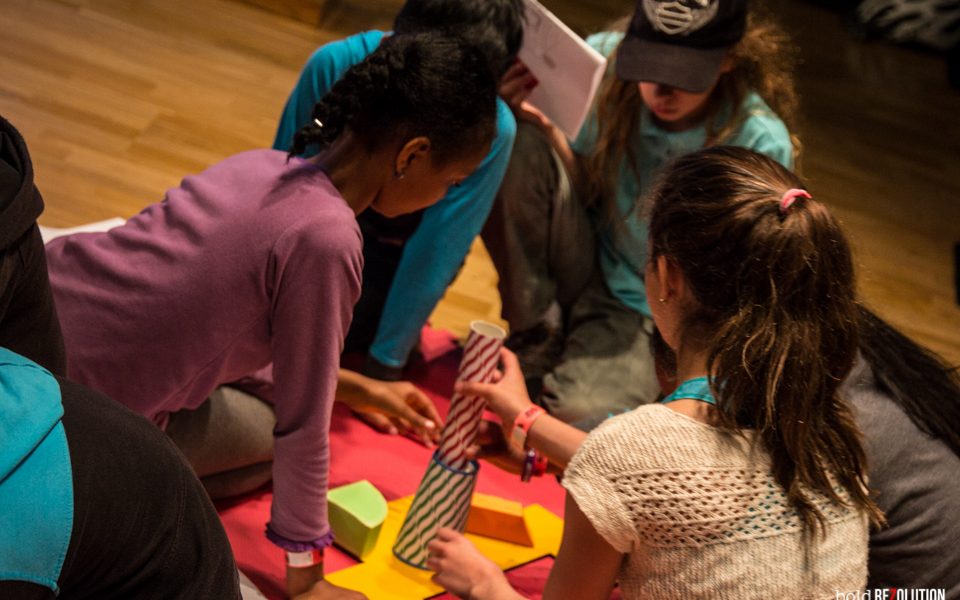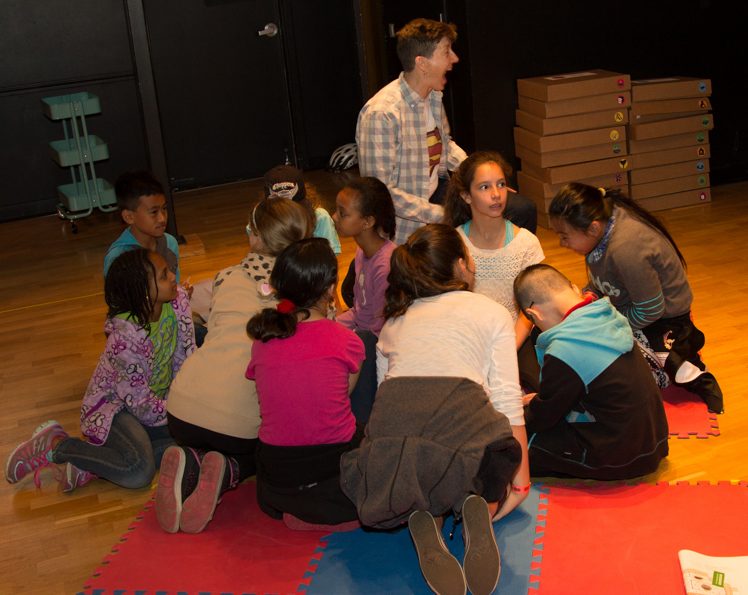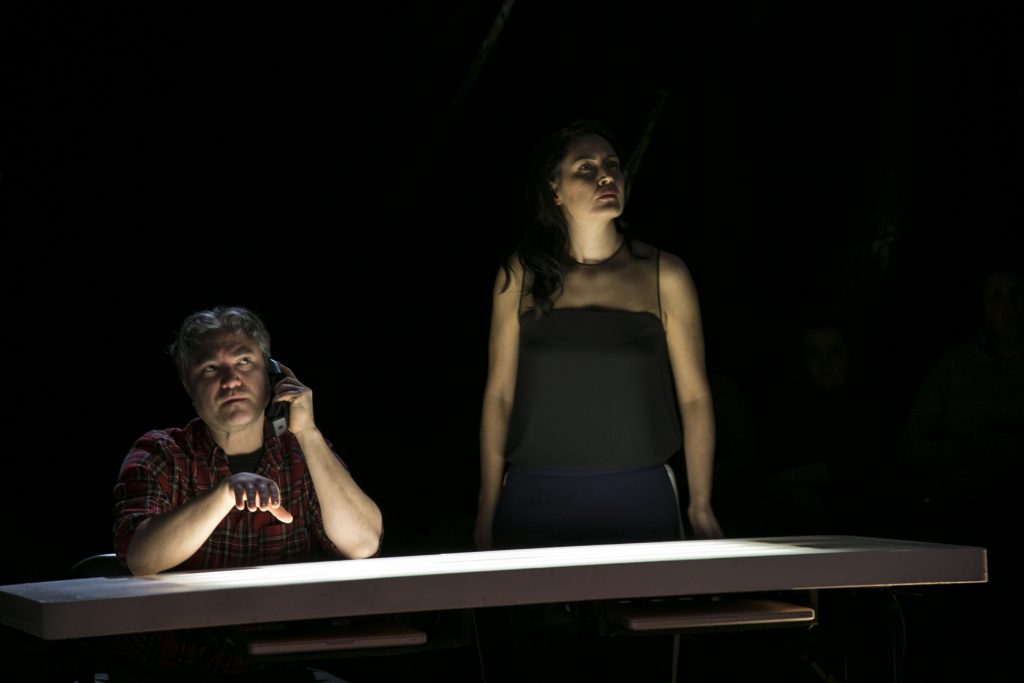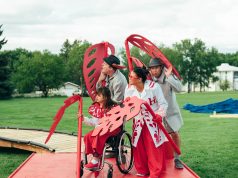
Every couple years I get malaise. This has happened enough times that I recognize the pattern, coming as it does between finishing one creative cycle, but before the next begins. The malaise is characterized by restlessness; do I still have time to become a physiotherapist, an early childhood educator, a sound engineer?
Most of all, I wonder: why make theatre at all? Does it even matter?
The first time I experienced malaise, I was fortunate to be taking a workshop with Linda Putnam, so I sought her counsel. Linda said that we will rarely see the impact of our work because it happens after the audience has left the theatre. Moments before talking to Linda, I was playing with a colleague’s 3-year-old son. Linda nodded at him in the corner eating snack and said, “what about kids?”
When kids are the audience, the impact is immediately apparent. You can see if they are in or out. In the words of Richard Greenblatt, the only truly political theatre is for young audiences. What surprised me over the years is the way my interest in working with and for young audiences would converge with my interest to create within a participatory aesthetic as a political and artistic choice.
To me, placing the audience at the centre of the creation not only means making choices that will create a positive experience of the artwork, it means that their experience is the artwork: where they move, what they see and hear, what they touch, to whom they speak and what they say. Ideally, these experiential aspects are balanced with elements that conventional theatre-goers might recognize, like story, character, and conflict.
Creating participatory theatre is a process of weighing and balancing all of these aspects to design and execute a coherent and unified experience. Ultimately, I want to make theatre experiences where the artists (myself and the collaborators with whom I work) agree to become invisible, conceding space to the participants, the audience. What began as an experiment, (best articulated by Dustin Harvey’s question, “can there be theatre without actors?”) is now a place where the dialogue is not only spoken by the audience but in some cases invented by them.

One of the current projects I’m working on is Me on the Map, a participatory show for kids about urban design and collective, ethical decision-making. Together with co-creator Jan Derbyshire, we’ve designed a theatrical experience performed in the style of “classroom” that begins before the kids reach the performance space, and (we hope) resonates long after they’ve left. Structurally, the performance alternates between the facilitator introducing new information, moderating dialogue, then breaking the audience into smaller groups to solve problems together.
Through the process of making Me on the Map, Jan introduced me to the notion of emergent dialogue – what the kids say to each other through the course of the show. This, to us, became a critical throughline for the action of the play. We eavesdropped and projected the kids’ observations on screens, typed it into show reports, or simply tried to remember the nuggets of brilliance to share with each other post-show.
These were the kids’ lines. And this dialogue of theirs was, arguably, more important than anything we wrote.
They talked to each other and listened.
These two actions are the building blocks of our societies. The talking, the listening, and the human impulses they grow emerge from. Before the written word, there is the spoken word. Before the spoken word, there are the ears hearing, the eyes seeing, the mind apprehending the presence of the other – and sometimes The Other.
To design a structure or container that allows for the audience – the kids – to fully see, hear and feel each other is a manifestation of Jan and my optimistic vision of humanity. It is utopian design. It says, “I see you and it is critical, absolutely imperative that you are here. And you. And you. And you….” The presence of each individual audience member necessarily changes the course of what is happening, it shapes the meaning of the event they are experiencing.
We hope that the kids who participate in Me On The Map might be more willing to participate in real life, too. That what we do will be interesting and meaningful enough that it will make some of those individuals want to keep speaking up. That their experience of affecting the course of events in a controlled environment might communicate, without words, that they could have this effect in real life, too. That the world is mutable and we, the people who live in it, shape it.

These ideas are not ground-breaking, google “Augusto Boal” for decades worth of work. Nor do these principles apply to kids only. In her article in last week’s CdnTimes, Chelsea Haberlin wrote about Act Two of The Pipeline Project as a necessary opportunity for audience members to talk to each other about the pressing ideas and issues introduced by the more conventionally presented Act One. The artists involved created space for the audience to grapple with difficult questions, and then the artists stepped back and allowed that to happen. I can only imagine that Act Two was just as emotionally gripping as the first act, with its own ups and downs, and possibly a sense of unpredictability that is difficult to construct.
As a wider community of theatre-makers, we frequently argue that one of the theatre’s key properties is its ability to pull individuals into the room together, to share space, and an experience. Participatory theatre takes this strength one step further and acknowledges the many subjective ways the performance can impact the audience. There is no objective, singular point of view. There are only each of our individual, blood-and-flesh-powered, meaning-making brains interpreting what we see, and determining how it makes sense to our individual selves.
Good storytelling is about unearthing and playing out our worst fears and having a few laughs along the way. What is more fearful than other people? This is exactly why I make theatre. To contrast the subjectivity of my own experience with that of another. To create a safe (and aesthetically pleasing) environment to attempt expression, to misunderstand, to hear, to correct, to be corrected, to disagree, and to endeavor to find a point of agreement, however small.
When faced with news stories describing abuse of authority, the rise of the extreme right, and hidden diseases waiting to be unleashed by melting ice caps, these small instances of connection seem like very good reasons to keep doing what we’re doing.









